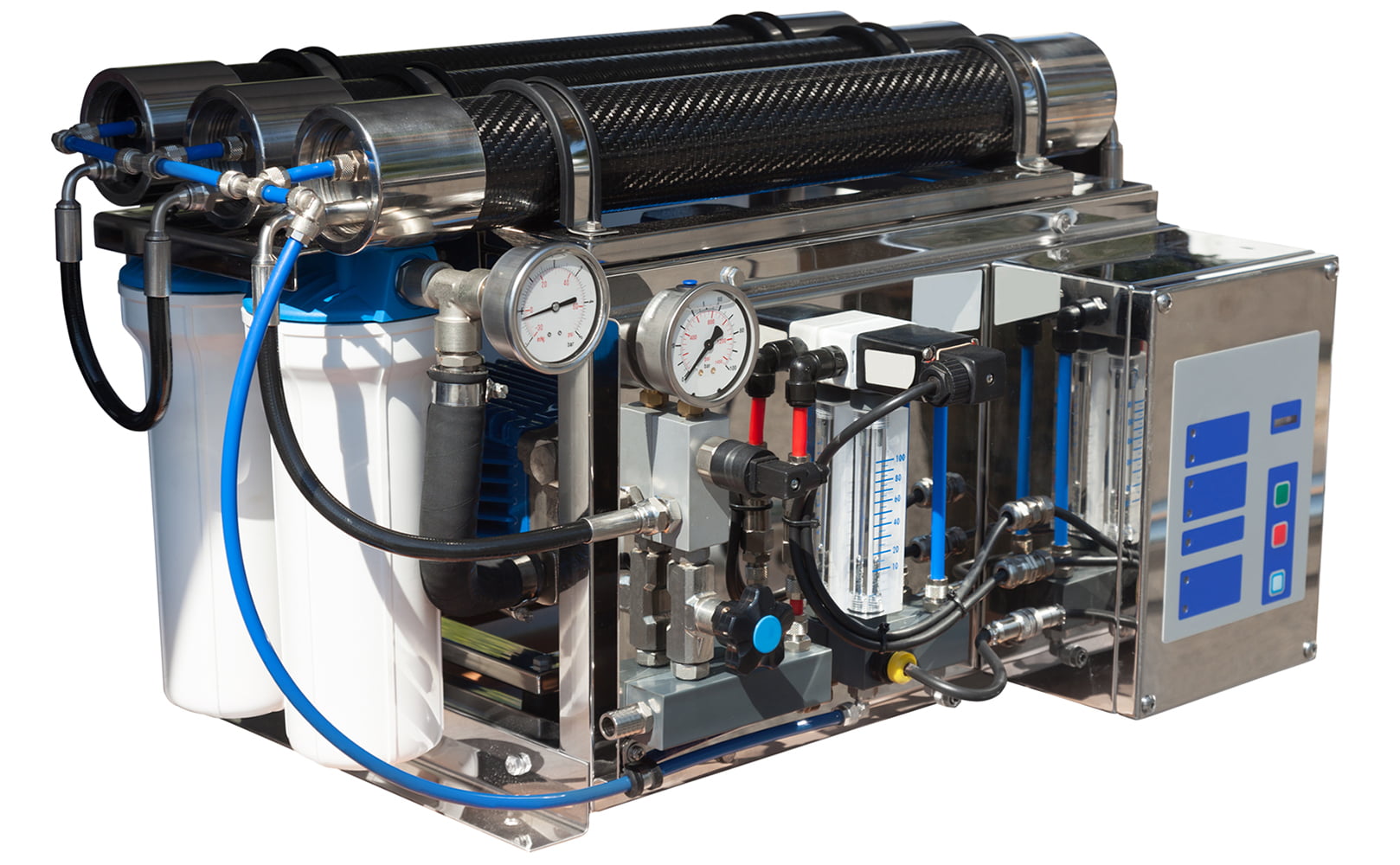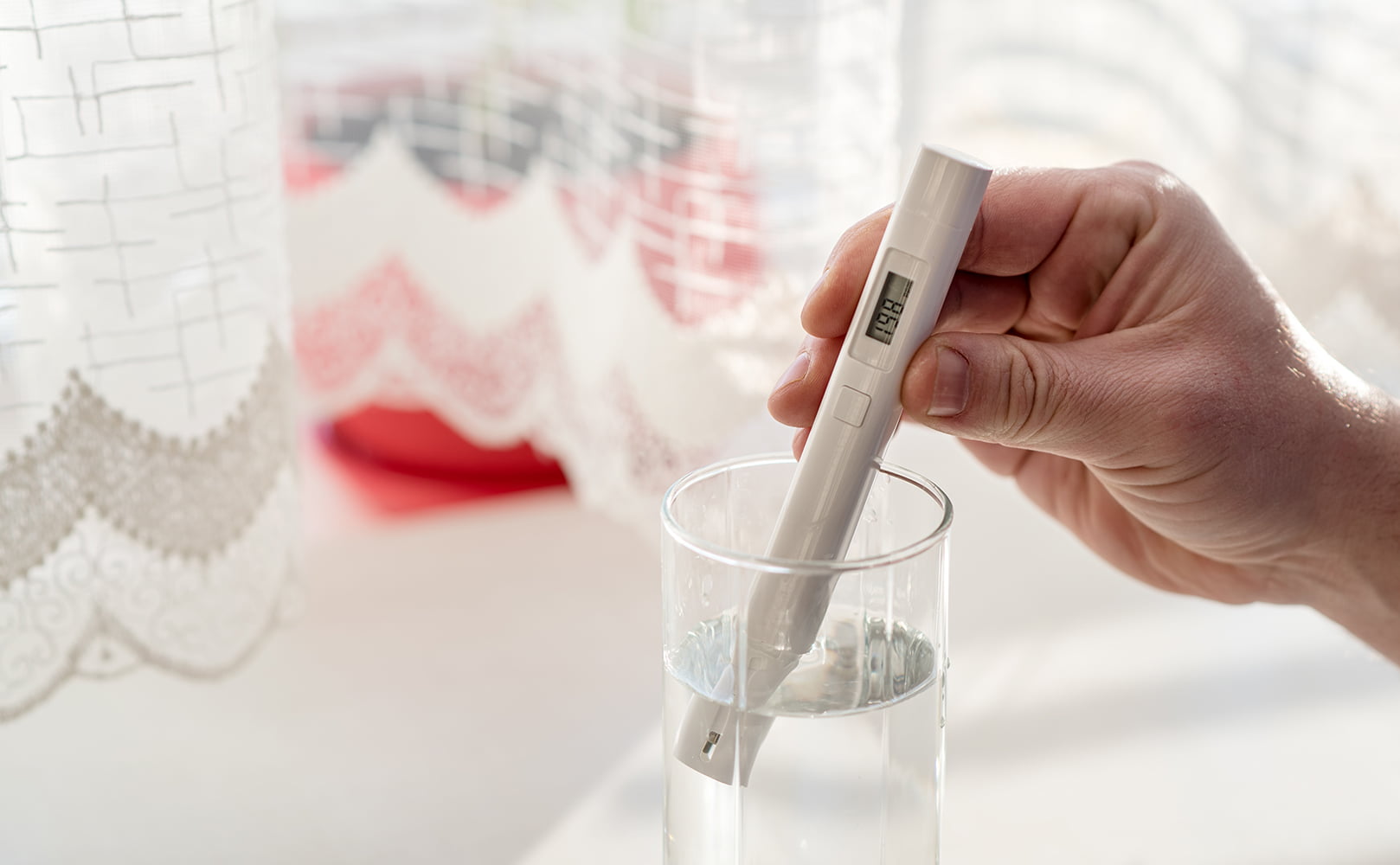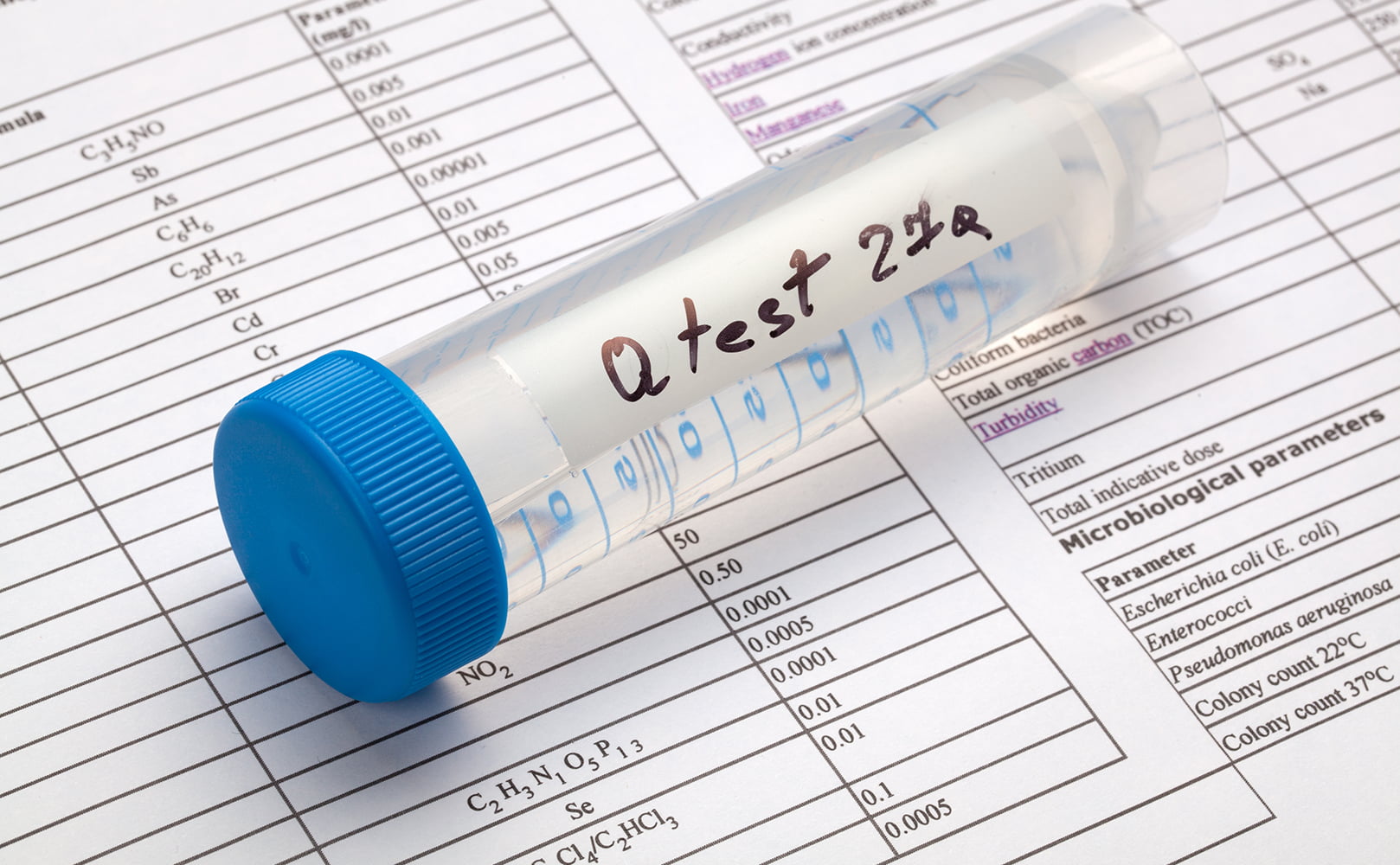How Does a Whole House Reverse Osmosis System Work?
Written by: Gene Fitzgerald // Last Updated: Jan 31, 2023
This page may contain affiliate links. If you buy a product or service through such a link we earn a commission at no extra cost to you. Learn more.
Whole house reverse osmosis systems work on a relatively simple principle – forcing water through a very thin membrane at high pressure.
However, the exact setup of the typical whole house RO system is quite complex and can take a while to understand if you’ve never dealt with a system like that before.
Let’s elaborate…
Key Takeaways
- The main idea behind whole house reverse osmosis filtration is forcing your home’s entire water supply through a semipermeable membrane at high pressure. This removes the vast majority of contaminants.
- During the process, the water is split into a clean and a contaminated water stream. The clean water is stored in a tank and delivered to your taps with a pressure pump. The wastewater is flushed down the drain.
- Usually, whole house reverse osmosis features pre-treatment like sediment and carbon filtration and water softening. This removes even more contaminants and protects the delicate RO membrane from fouling.
- Post-treatment may be used, for example to balance water pH using a calcite filter or UV light for disinfection.
What Is a Whole House Reverse Osmosis System?
A whole house reverse osmosis system filters the water coming into your home, providing you with fresh, clean water at every access point in the house. You don’t have to restrict yourself to using one specific faucet that has a filter attached to it, and you can enjoy the benefits of filtered water for all purposes, including showering and washing your clothes.
How Does a Whole House Reverse Osmosis System Work?
So, how does a whole house reverse osmosis system work?
The basic idea behind whole house reverse osmosis is simple, as we said above. Your entire water supply is forced through a semipermeable RO membrane, which only allows water molecules to pass through. This is a very effective method of removing most types of contaminants from said water.
Stages of a Whole House RO System
The typical whole house RO system has several stages, including pre-filtration and post-treatment. These may vary from house to house, depending on what kinds of contaminants you’re trying to address and the overall quality of your water.
You’d often have pre-filtering steps that remove contaminants like sediment and dirt, chlorine and other chemicals, and hard water minerals, improving the performance of the RO filtration process itself.
Next comes the RO membrane.
And then you have post-filtration. This may include a UV light system for water disinfection and a calcite filter to balance water pH (RO water is usually slightly acidic).
What Does the Electronic Control Do?
The electronic control allows you to monitor and adjust the system from a centralized location, including regulating the incoming water pressure and setting the tank levels at which the system should automatically start and stop. You might have additional controls on your panel, like a low-pressure shutdown feature and automatic membrane flushing.
The Storage Tank
As water is being purified, the connected storage tank begins to fill. Once full, a float switch shuts off the entire RO unit. No more water is being filtered at this point until you draw water from the storage tank. This activates a delivery pump which repressurizes the water so that it can move through your plumbing.
If enough water is drawn from the tank, the float switch reopens which activates the RO process. More purified water is produced and stored in the tank.
How Reverse Osmosis Works
The basic idea behind reverse osmosis is that water is pushed through a semipermeable membrane with very small pores. Here, the water is split into two streams – the permeate, which is the purified portion of the water, and the reject, which is water containing all the rejected contaminants.
The membrane’s openings are small enough that only water molecules can pass through them. A very small percentage of contaminants may also make it through, but this is typically less than 10% of the original impurities found in the incoming water supply.
What is being removed? With the right pre and post-treatment in place, a whole house RO water filtration system removes water disinfectants and their byproducts, heavy metals such as lead, salts including nitrates, pesticides, herbicides, PFAS, sediment, and even microorganisms (among other stuff).
By the way, pressure is an important factor in any reverse osmosis system. Without it, the system won’t work. Water must be pushed through the membrane to achieve the desired purification effect.
Whole House RO System Components
Here’s a brief rundown of the components found in the typical whole house reverse osmosis system. Pretty much all systems on the market follow this setup, although there might be some individual differences depending on your water conditions.
Feed Water Valve
This is simply the valve that connects the system to your plumbing, serving as the input.
Sediment Pre-Filter
A pre-filtration stage is necessary for removing contaminants like sediment and dirt. Without this stage, the effectiveness of an RO membrane would be greatly reduced.
RO Membrane + Pressure Housing
The main component of a reverse osmosis system. The membrane is housed in a long tube through which all water passes.
Pressure Gauges
Pressure gauges let you monitor the pressure levels in different parts of the system, including the pre-filters, the pump, and any additional filtration steps.
Flow Meters
Controlling your water flow is important for the optimal use of a reverse osmosis system. Flow meters provide you with a real-time overview of the current situation.
Valves
A reverse osmosis system utilizes a number of valves. Typically, there’s one for each major component of the system, including wastewater disposal, recycling, and other large elements along the chain.
Pumps
Pumps are used in various ways in a reverse osmosis system. The most obvious one is for providing the necessary pressure for the reverse osmosis process itself. But you’ll usually find various other pumps in your system, including one for the feed water, the repressurization stage, and more.
Pressure Switch
The pressure switch allows you to easily control the system’s pressure levels and shut it off in emergency cases.
Electronic Control Panel
A centralized place for controlling most aspects of the system. Your control panel might have different switches depending on the exact setup.
Storage Tank
A storage tank is useful for having a constantly available supply of fresh water without having to wait for it to be purified first.
What Does a Whole House Reverse Osmosis System Remove?
Reverse osmosis is great for purifying water, but it’s important to remember that it doesn’t remove all types of contaminants. It’s designed for dealing with a specific list of them, although that list is pretty extensive and covers many problems that people tend to experience with their water supply.
- Various types of heavy metals
- Microbes, including bacteria and cysts
- Chemicals like chlorine and their byproducts
- Pesticides and herbicides
- Most types of minerals and salts
- Sediment
Does Whole House RO Waste a Lot of Water?
One major downside of the reverse osmosis process is that it can be very wasteful. For each gallon of purified water, several gallons are wasted. This is usually the case for point of use systems, but the effectiveness of your purification can be greatly improved when using whole home RO because it uses additional pressure pumps. You can also look into recycling the reject water, which will reduce your wastage by a good amount.
Sophisticated whole house RO systems waste as little as 1 gallon for every 5 gallons filtered.
How Do You Maintain a Whole House RO Water Filtration System?
You’ll need to pay attention to several components of your whole house RO system to keep it in a good operating condition.
- You should replace the sediment pre-filter roughly every 6-9 months, as well as the carbon pre-filter.
- The reverse osmosis membrane will eventually need to be swapped out too, though it can last for up to 5 years under optimal conditions.
- If you’re using a remineralizer, you’ll have to replace the calcite filter cartridge, too, based on the manufacturer’s recommendations.
- Sanitizing the whole system including the RO storage tank is required every 1-2 years.
How Much Does a Whole House Reverse Osmosis Cost?
The minimal cost of a whole house reverse osmosis system is around $500, and that’s only for a very basic model with no extras. If you want an atmospheric tank + delivery pump, you’re looking at $1,000-2,000 minimum as a more realistic estimate.
It’s quite possible that your system costs much more than that, going up to $10,000+ in many cases involving larger households with severe contamination problems.
What to Consider When Buying
If you’re buying your first POE reverse osmosis system, you should take some time to explore what the market has to offer and what options you can pick from. Here are some of the main considerations you should make.
System Sizing
Larger households will need more advanced systems to keep up with their demand, especially with regards to pressure and flow rates. Pay attention to the output rate of the system you’re buying to ensure that it can supply enough water for your whole household without any compromises. Using a large storage tank can offset some of your shortcomings in this regard, but it won’t address the underlying problem.
Pre and Post-Filtration
Pre-filtration is often important when you’re dealing with heavily contaminated water. Some types of contaminants can negatively affect the operation of your reverse osmosis system and have to be removed in advance. You may also want to apply post-filtration steps and even additional treatment, like a remineralization stage. UV purifiers are commonly used as a post-treatment stage in whole house RO setups.
Wastewater
Check how much water will be wasted in the filtration process. One of the downsides of reverse osmosis is that it produces a lot of wastewater, with the ratio sometimes being as high as 1:5.
Space
Make sure you have enough space for the whole system to begin with. A reverse osmosis system can already be quite large even for a basic model – and when you add various extra components like additional filtration stages, it can take up quite a lot of space.
Do You Really Need a Whole House Reverse Osmosis System?
Not everyone needs a whole house reverse osmosis system. If your water is already treated before it reaches your household, additional filtration may be redundant and unnecessarily expensive. In fact, reverse osmosis may actually reduce the quality of your drinking water in this case. It will remove various minerals which may have a positive effect on your health normally.
Test Your Water!
To find out for sure whether you need a reverse osmosis system or not, it’s recommended to have your water tested professionally. This involves taking a sample of your water and submitting it to a testing facility. Note that this is not the same as running a DIY test with a store-bought kit. Those tests are far less precise and don’t paint the full picture.
If you have any thoughts about the question, how does a whole house reverse osmosis system work, please don’t hesitate to leave a comment below!
Information provided on BOS is for educational purposes only. The products and services we review may not be right for your individual circumstances.
We adhere to strict editorial guidelines. Rest assured, the opinions expressed have not been provided, reviewed, or otherwise endorsed by our partners – they are unbiased, independent, and the author’s alone. Our licensed experts fact-check all content for accuracy. It is accurate as of the date posted and to the best of our knowledge.




